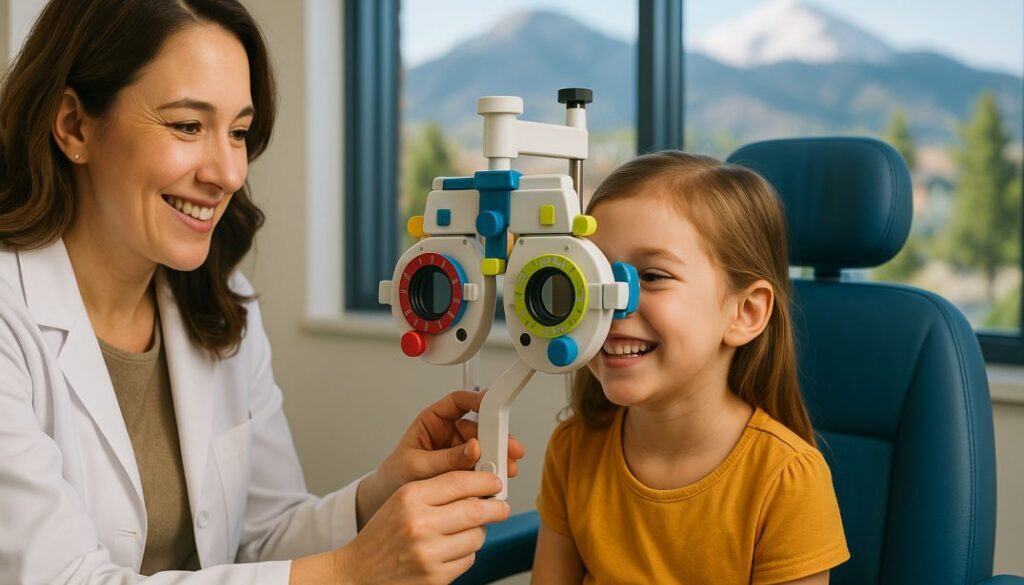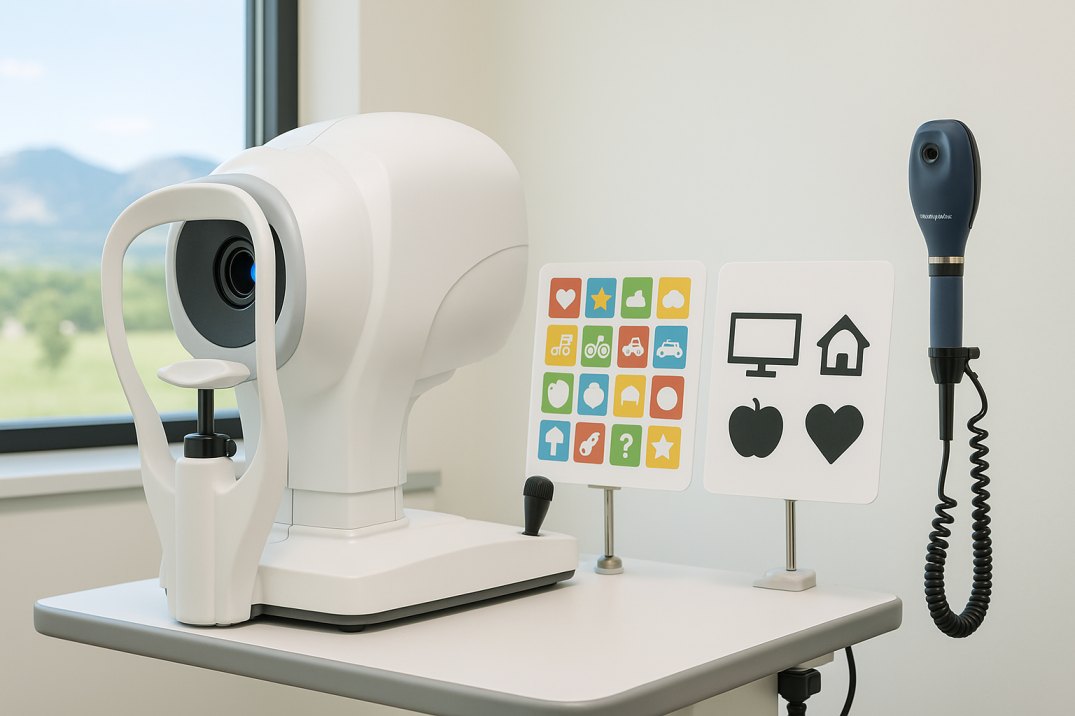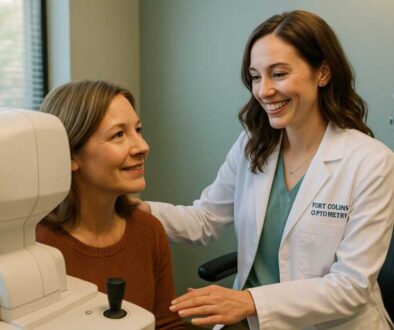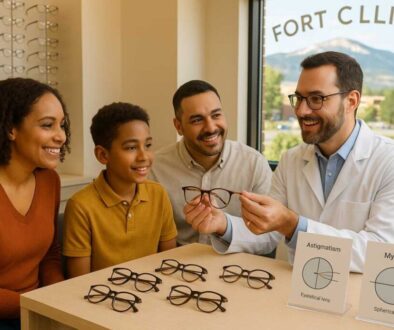Pediatric Eye Care Fort Collins: When Should Your Child See an Eye Doctor?
Your child’s vision is their window to the world, shaping how they learn, play, and develop. In Fort Collins, ensuring your little one receives proper pediatric eye care can make the difference between a lifetime of clear sight and permanent vision problems that could have been prevented.
According to experts, 80% of learning is visual, which means that if your child is having difficulty seeing clearly, his or her learning can be affected. Recent 2024 studies show that vision screening prevalence has declined from 69.6% to 60.1% over five years, making it even more crucial for Fort Collins parents to be proactive about their children’s eye health.
At Poudre Valley Eyecare, we’ve been Fort Collins’ trusted partner in family eye health for over 25 years, providing comprehensive, compassionate care that’s accessible to every member of our community. Our experienced pediatric optometrists understand that children’s eye problems are unique because their vision is still developing, and we’re here to guide you through every step of your child’s eye care journey.
Understanding the Critical Importance of Pediatric Eye Care
Why Early Eye Care Matters for Fort Collins Families
According to the American Public Health Association, about 10% of preschoolers have eye or vision problems. However, many of these conditions go undetected because children often don’t realize they have vision problems or lack the words to express what they’re experiencing.
Children’s eyes and vision undergo rapid development during their first eight years of life. During this critical period, any condition that prevents clear vision can permanently affect how the brain processes visual information. Amblyopia generally develops from birth up to age 7 years. It is the leading cause of decreased vision among children.
The good news? Most childhood vision problems are treatable when caught early. That’s why establishing a relationship with a trusted kids’ eye doctor near me in Fort Collins is essential for protecting your child’s sight and supporting their overall development.
The Fort Collins Advantage: Local Expertise You Can Trust
Living in Fort Collins means you have access to world-class pediatric eye care without traveling to Denver or Boulder. Our community is home to experienced optometrists who specialize in children’s vision, understand the unique needs of Northern Colorado families, and accept most insurance plans including Medicare and Medicaid.
When you choose local pediatric eye care in Fort Collins, you’re not just getting convenience—you’re getting providers who understand our community’s lifestyle, from the importance of outdoor activities to the visual demands of our excellent schools.
When Should Your Child First See an Eye Doctor? The Complete Timeline
Infant Eye Care: Birth to 6 Months
Your child’s journey with eye care should begin much earlier than you might think. The American Academy of Ophthalmology recommends eye screenings for newborns, babies between 6 and 12 months, babies between 12 and 36 months, toddlers between 3 and 5 years old, and at age 5.
First Eye Screening: Birth. Every newborn should receive an initial eye examination in the hospital to check for congenital conditions such as cataracts, infections, or other abnormalities that could affect vision development.
6-Month Milestone. At about the age of six months, you should schedule a thorough eye exam for your baby, even if they are not showing any signs of eye or vision problems. At this age, babies have developed enough to undergo more comprehensive testing, and eye doctors can assess:
- Eye movement and alignment
- Visual tracking abilities
- Overall eye health
- Signs of conditions like strabismus or significant refractive errors
Toddler Vision Care: 12 Months to 3 Years
During the toddler years, children experience tremendous growth in visual skills. The Bright Futures/American Academy of Pediatrics Periodicity Schedule recommends vision screening for toddlers aged 1 and 2 years.
This is when many conditions like crossed eyes (strabismus) or lazy eye (amblyopia) may first become apparent. However, these conditions aren’t always obvious to parents, which is why professional screening is crucial.
Preschool Eye Exams: Ages 3-5
Between the ages of 3 and 5, your child should have a thorough, in-person optometric eye examination to make sure his or her vision is developing properly and there is no evidence of eye disease.
This comprehensive exam is particularly important because:
- Children are developing the visual skills they’ll need for school
- Many eye conditions become more apparent during this age range
- Treatment is most effective when started early
- With today’s diagnostic equipment and tests, a child does not have to know the alphabet or how to read to have his or her eyes examined.
School-Age and Beyond: Ongoing Care
The AAP recommends that vision screening start around age 3 and occur each year at ages 4, 5, and 6. After that, screening should occur at ages 8, 10, 12, and 15.
For school-aged children who wear glasses or contacts, annual exams are typically recommended. Children without vision correction should still have their eyes checked every 1-2 years.
Warning Signs: When to Schedule an Eye Exam Immediately
Red Flags for Infants and Toddlers
Even before your child can tell you about vision problems, there are signs you can watch for:
- Eyes that don’t track together or appear crossed after 3 months of age
- Excessive tearing or discharge
- White pupil or unusual light reflection in photos
- Frequent eye rubbing beyond normal tired behavior
- Sensitivity to light
- One eyelid that droops significantly
Developmental Concerns:
- Not making eye contact by 6-8 weeks
- Difficulty tracking moving objects for 3 months
- Not reaching for toys or showing interest in faces
- Seeming to favor one side when looking at objects
Signs in Preschool and School-Age Children
Parents should watch for signs that may indicate a vision problem, including: Sitting close to the TV or holding a book too close. Squinting. Tilting their head. Covering an eye. Frequently rubbing their eyes. Short attention span for the child’s age. Turning of an eye in or out. Sensitivity to light. Difficulty with eye-hand-body coordination when playing ball or bike riding. Avoid coloring activities, puzzles, and other detailed activities.
Academic and Behavioral Red Flags:
- Difficulty in school, particularly with reading or math
- Complaints of headaches, especially after visual tasks
- Avoiding activities that require close work
- Poor hand-eye coordination
- Difficulty catching or hitting balls
- Sitting very close to the TV or holding books close to their face
When Reading and Learning Become Difficult: If your child is struggling academically, vision problems could be a contributing factor. Undetected or uncorrected vision problems can cause children and teens to suffer academically, socially, athletically, and personally.
Emergency Situations
Seek immediate medical attention if your child experiences:
- Sudden vision loss or significant vision changes
- Eye injury or trauma
- Severe eye pain
- Sudden onset of double vision
- Flashing lights or the sudden appearance of many floaters
Common Pediatric Eye Conditions in Fort Collins Children
Amblyopia (Lazy Eye)
Amblyopia, also called “lazy eye,” is when one or both eyes don’t see well even with glasses. It happens when something affects how the vision develops in childhood.
Amblyopia affects approximately 2-3% of children and is the leading cause of vision loss in one eye among children and young adults. The condition develops when the brain favors one eye over the other, essentially “turning off” the weaker eye.
Types of Amblyopia:
- Strabismus amblyopia: Results from eye misalignment
- Refractive amblyopia: Caused by significant differences in prescription between eyes
- Deprivation amblyopia: Results from something blocking vision, such as a cataract
Treatment Options: Treatment is most effective when started early and may include:
- Corrective glasses or contact lenses
- Eye patching therapy
- Atropine drops
- Vision therapy
- Surgery in some cases
Strabismus (Crossed Eyes)
Strabismus is one of the most common eye conditions in children, affecting between 2 and 4 percent of the population. Strabismus occurs when the eyes are not aligned properly.
Strabismus can appear as:
- Eyes turning inward (esotropia)
- Eyes turning outward (exotropia)
- Eyes turning upward (hypertropia)
- Eyes turning downward (hypotropia)
Why Early Treatment Matters: If strabismus is treated early, your child will have a better chance to use his or her eyes together to develop binocular vision and depth perception. Without treatment, strabismus can lead to amblyopia and permanent vision problems.
Refractive Errors
Many children in Fort Collins develop refractive errors that require correction:
Myopia (Nearsightedness): Increasingly common in children, myopia makes distant objects appear blurry. Recent studies show that myopia now affects 35.8% of children globally, with projections that 740 million children could be affected by 2050. The prevalence has tripled between 1990 and 2023, with the increase particularly notable after the COVID-19 pandemic.
Hyperopia (Farsightedness): Makes near objects appear blurry and can cause eye strain even when distance vision seems fine.
Astigmatism: Causes blurred vision at all distances due to an irregularly shaped cornea.
Other Common Conditions
- Blocked tear ducts: Common in infants, often resolving on their own
- Pink eye (conjunctivitis): Infectious or allergic inflammation
- Ptosis: Drooping eyelid that may affect vision development
- Color vision deficiency: Affects the ability to distinguish certain colors
What to Expect During Your Child’s Eye Exam in Fort Collins
Age-Appropriate Testing Methods
Pediatric eye doctors use specialized techniques designed for each developmental stage:
Infants (0-6 months):
- Pupil response testing
- Fixation and following assessments
- Red reflex examination
- External eye examination
Toddlers (6 months – 3 years):
- Preferential looking. This test will measure your baby’s vision, using special cards that are blank on one side and striped on the other, to attract the baby’s gaze.
- Basic alignment assessments
- Simple tracking exercises
Preschoolers (3-5 years):
- LEA Symbols: these are similar to an adult’s eye tests using charts with letters, with the exception of symbols are used instead of letters in these tests. Some of these symbols include an apple, house, square and circle.
- Picture identification charts
- Basic visual acuity measurements
School-age children:
- Traditional letter charts
- Comprehensive refraction
- Detailed eye health examination
- Color vision testing
- Depth perception assessment
Making the Experience Positive
Fort Collins pediatric eye doctors understand that eye exams can be intimidating for children. “We know they can be stressful for both children and parents.”
Modern pediatric practices use:
- Kid-friendly equipment and environments
- Engaging explanations and demonstrations
- Rewards and positive reinforcement
- Age-appropriate communication
Choosing the Right Pediatric Eye Doctor in Fort Collins
What to Look for in a Kids’ Eye Doctor Near You
When searching for “kids eye doctor near me” in Fort Collins, consider these important factors:
Specialized Training: “Pediatric ophthalmologists have specialized training in children’s eyesight that goes above and beyond other eye care providers.”
Experience with Children: Look for providers who:
- Regularly see pediatric patients
- Have child-friendly offices and equipment
- Use age-appropriate communication techniques
- Make children feel comfortable and safe
Community Connection: Fort Collins families benefit from choosing local providers who:
- Understand our community’s needs
- Accept local insurance plans
- Provide convenient scheduling
- Offer emergency care when needed
Insurance and Accessibility
Quality pediatric eye care should be accessible to all Fort Collins families. At Poudre Valley Eyecare, we accept most major insurance plans, including Medicare and Medicaid, ensuring that financial barriers don’t prevent your child from receiving necessary eye care.
The Role of Vision in Learning and Development
Academic Success Starts with a Clear Vision
A recent study found that children frequently experience difficulty accessing follow-up after referral from a vision screening. Available research shows that children frequently experience difficulty accessing follow-up after referral from a vision screening. This gap in care can have serious consequences for academic performance.
Visual Skills Essential for Learning:
- Eye tracking and focusing
- Eye teaming and coordination
- Visual processing and perception
- Hand-eye coordination
- Depth perception
The Fort Collins School Connection: Our local schools do their best to identify vision problems, but recent data shows that only 53.2% of children receive recommended vision screening. School vision screenings offer limited testing, typically only assessing distance vision rather than the comprehensive visual skills needed for effective learning, reading, and computer use – all essential for school success.
Supporting Your Child’s Visual Development at Home
Encourage Healthy Visual Habits:
- Follow the 20-20-20 rule during screen time
- Ensure good lighting for reading and homework
- Encourage outdoor play and activities
- Provide a balanced diet rich in eye-healthy nutrients
- Model good eye care habits
Recognize the Impact of Modern Technology: With increased screen time, Fort Collins children face new challenges to their vision development. Regular pediatric eye care Fort Collins providers emphasize monitoring for digital eye strain and developing myopia.
Protecting Your Child’s Vision: A Fort Collins Parent’s Guide
Preventive Measures for Healthy Eyes
Sun Protection: Colorado’s high altitude and abundant sunshine make UV protection crucial. Ensure your child wears:
- Quality sunglasses with UV protection
- Wide-brimmed hats during outdoor activities
- Protective eyewear during sports
Safety First:
- Use safety goggles during sports and activities
- Childproof your home to prevent eye injuries
- Teach children about eye safety
- Keep harmful chemicals and sharp objects away from children
Nutrition for Healthy Eyes: Encourage foods rich in:
- Vitamin A (carrots, sweet potatoes)
- Omega-3 fatty acids (fish, nuts)
- Antioxidants (leafy greens, berries)
- Vitamin C (citrus fruits, peppers)
Building a Lifetime of Good Eye Health
Establishing good eye care habits early sets the foundation for a lifetime of healthy vision. Regular check-ups with your Fort Collins pediatric eye doctor help ensure:
- Early detection of developing problems
- Timely treatment when needed
- Monitoring of changes as your child grows
- Education about maintaining healthy vision
Recent Research Supporting Early Pediatric Eye Care
Evidence-Based Benefits of Early Intervention
A 2023 study published in Children found that pediatric vision screening detects children at risk for visual conditionsconnectingg those in need with an eye care provider for evaluation and treatment. The primary aim of vision screening in younger children is the detection of those at risk for amblyopia, which can result in irreversible vision loss if left untreated.
The Impact of Delayed Care
Research shows that roughly 3% of children younger than 18 years in the United States experience visual impairment or blindness. Visual impairment in childhood can lead to significant deficits in overall functioning. It is estimated that by 2060, the number of children between 3 and 5 years of age with visual impairment will increase by 26% in the United States, owing in part to vision loss easily prevented by early detection.
Fort Collins Community Support
A recent randomized clinical trial showed that school-based vision programs can significantly impact academic performance, with studies demonstrating improved outcomes when vision problems are identified and treated promptly.
Taking Action: Your Next Steps for Your Child’s Eye Health
Schedule Your Child’s Eye Exam Today
Don’t wait for problems to become apparent. Early detection and treatment provide the best outcomes for your child’s vision and overall development. Whether you’re searching for “pediatric eye care Fort Collins” or “kids eye doctor near me,” you’ll find experienced, caring professionals ready to support your family’s eye health needs.
Choose Poudre Valley Eyecare for Your Family
For over 25 years, Poudre Valley Eyecare has been Fort Collins’ trusted partner in comprehensive family eye care. Our experienced team understands the unique needs of growing children and provides:
- Comprehensive pediatric eye examinations
- Kid-friendly environments and techniques
- Expert diagnosis and treatment of childhood eye conditions
- Insurance acceptance, including Medicare and Medicaid
- Convenient Fort Collins location
- Emergency eye care when you need it most
Connect with Fort Collins’ Premier Pediatric Eye Care
Your child’s vision is precious and irreplaceable. By choosing proactive pediatric eye care, you’re investing in their academic success, social development, and lifelong quality of life.
Don’t let treatable vision problems impact your child’s potential. Schedule a comprehensive pediatric eye exam today and give your child the clear vision they need to explore, learn, and thrive in our beautiful Fort Collins community.
Contact Poudre Valley Eyecare today to schedule your child’s comprehensive eye examination. Our experienced team is ready to provide the caring, professional pediatric eye care your family deserves.
FAQs
-
Children should have their first eye exam at 6 to 12 months old, even if there are no noticeable problems
Please note: None of the above should be considered medical advice. If you’re having any concerns about your vision, please reach out to us immediately or see your primary care provider.






